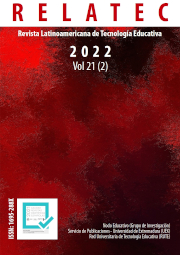Technology as a complement to the teaching-learning process of the recorder in the primary education stage
DOI:
https://doi.org/10.17398/1695-288X.21.2.131Keywords:
Musical education, Information and communications technologies, Flute, Melodic SimilarityAbstract
Many countries incorporate the study of the recorder into the teaching of music in primary education. The students have a group class per week of no more than one hour in duration, being a complex that performs a real individualization of the learning process. After the collective class, the students have to practice at home alone, with the responsibility for their progress in the study falling on themselves.This work proposes the inclusion of a digital tool as a complement to the deficiencies that the teaching-learning process of the instrument presents, as well as a proposal for a study protocol to be followed by the student in their autonomous progress.TThe objective of the computer application is to offer the possibility of listening to the musical piece, showing the score, recording the performances and, finally, providing references and data on the mistakes made, both to the students and to the teaching figure. This information, until now unknown, causes the traditional teaching model to be completely transformed. After carrying out the inclusion and evaluation of both proposals in an educational context, positive conclusions have been obtained that show the substantial improvement of the teaching-learning process of this musical instrument.
Downloads
References
Alemañy, C. (2009). La docencia: enfermedades frecuentes de esta profesión. Cuadernos de educación y desarrollo, DOI: https://ideas.repec.org/a/erv/cedced/y2009i224.html
Bromley, K. (2012). Using Smartphones to Supplement Classroom Reading. Reading Teacher, 66(4), 340-344. https://doi.org/10.1002/TRTR.01130
Bowles, C. (1999). Actividades musicales preferidas de los estudiantes de primaria. Música y Educación, 38, 148-149
Boza, A. C., & Toscano, M. (2002). Motivos, actitudes y estrategias de aprendizaje: aprendizaje motivado en alumnos universitarios. Revista de Currículum y Formación del Profesorado. DOI: redalyc.org/pdf/567/56724377008.pdf
Cappellari, A. (2009). Método fácil para el estudio de la flauta dulce. Barcelona, Nueva Carisch, 2009.
Carretero, M. (2009). Comprensión y motivación. Constructivismo y educación. Paidós.
Escudero, M. P. (1990). Canciones para Flauta Dulce soprano y guitarra. Madrid: Real Musical. Escudero, M. P. (1992). Madrid: Real Musical.
Ericsson, K., Krampe, R., Tesch-Römer, C. (1993). The role of deliberate practice in the acquisition of expert performance. Psycological Review, 100
Gangoso, M., & Blanco, M. (2008). El profesor que evalúa: La evaluación para la mejora de la acción educativa. En J. Sánchez, Compendio de Didáctica General. Editorial CCS
Goleman, D. (1998). La práctica de la inteligencia emocional. En Inteligencia emocional. Barcelona. Kairos. S.A.
Gustems Carnicer, J., Calderón, D., Navarro Calafell, M., & Segura, G. (2020). La flauta de pico en la escuela: la opinión del maestro de música. Revista Electrónica de LEEME, 2020, núm. 46
Herrera, S., & Fennema, M. (2011). Tecnologías móviles aplicadas a la educación superior. XVII. Congreso Argentino de Ciencias de la Computación: http://sedici.unlp.edu.ar/bitstream/handle/10915/18718/Documento_completo. pdf?sequence=1&isAllowed=y
Jambrina, M.E. (2007). La flauta dulce en el área de expresión artística en la educación primaria: Comunidad autónoma de Extremadura. Realidad, implicaciones y propuestas para el profesorado. Badajoz: Universidad de Extremadura.
Kageyama, N. (2013) Músico a prueba de balas. Cuántas horas al día debes practicar.https://bulletproofmusician.com/how-many-hours-a-day-should-you-practice/?
highlight=how%20many%20hours%20a%20day%20should%20you%20practice
Kongaut, Ch., y Bohlin, E. (2016). Investigating mobile broadband adoption and usage: A case of smartphones in Sweden. Telematics and informatics, 33(3), 742-752.
Molina, E. (2012) Puntuación automática de la voz cantada basada en medidas de similitud melódica. Universidad Pompeu Fabra.
Montoya, J.C. (2017). El recorrido de las metodologías de principios del siglo XX en la enseñanza de la música en España: aproximación bibliográfica e interpretativa. Anuario Musical, 72.
Orff, C. y Keetman, G. (1950). Musik für Kinder. Vol 1. Im Fünftonraum. Mainz: Mainz Schott.
Oriol, N. (2004). Metodología cuantitativa y cualitativa en la investigación sobre la formación inicial del profesorado de educación musical para primaria. Aplicación a la formación instrumental. Revista Electrónica Complutense de Investigación en Educación Musical - RECIEM, 1, 1-63.
Renwick, J., & McPherson, G. (2002). Interest and choice: student-selected repertoire and its effect on practicing behavior. British Journal of Music Education, 19.
Salmon, P. (1990). A psycological perspective on musical performance anxiety: a review of the literature. Medical Problems of Performing Artists, 5, 2-11.
Sloboda, J. (2000). Individual differences in music performance. Trends in Cognitive Sciences, 4(10), DOI:10.1016/S1364-6613(00)01531-X.
Tocino García, J. T. (2011). oFlute: reconocimiento de señales aplicado al aprendizaje de flauta dulce. DOI https://rodin.uca.es/handle/10498/14416
Topping, K. (2005). Trends in peer learning. Educational Psychology, 25(6), 631– 645.
Trueba, B., Barragan, S., Velez, M., & Perez, E. (1993). Materiales para la Reforma. Educación Primaria. Centro de Publicaciones. M.E.C. (1991-92). Madrid.
Downloads
Published
Issue
Section
License
Authors who publish in this journal accept the following conditions:
1. The Author retains copyright in the article. Upon acceptance of the article, the author shall grant to the Publisher the right of first publication of the article. with the dcoument registered with the Creative Commons Attribution-NonCommercial-NoDerivative 4.0 International (CC BY-NC-ND) license, which allows to third parties to use what is published whenever they mention the authorship of the work and the first publication in this journal.
2. Authors can make other independent and additional contractual agreements for the non-exclusive distribution of the article published in this journal (eg, include it in an institutional repository or publish it in a book) provided they clearly indicate that the work was published for the first time in this journal.
3. Authors are allowed and recommended to publish their work on the Internet (for example on institutional or personal pages) before and during the review and publication process, as it can lead to productive exchanges and a greater and faster diffusion of published work (see The Effect of Open Access).









